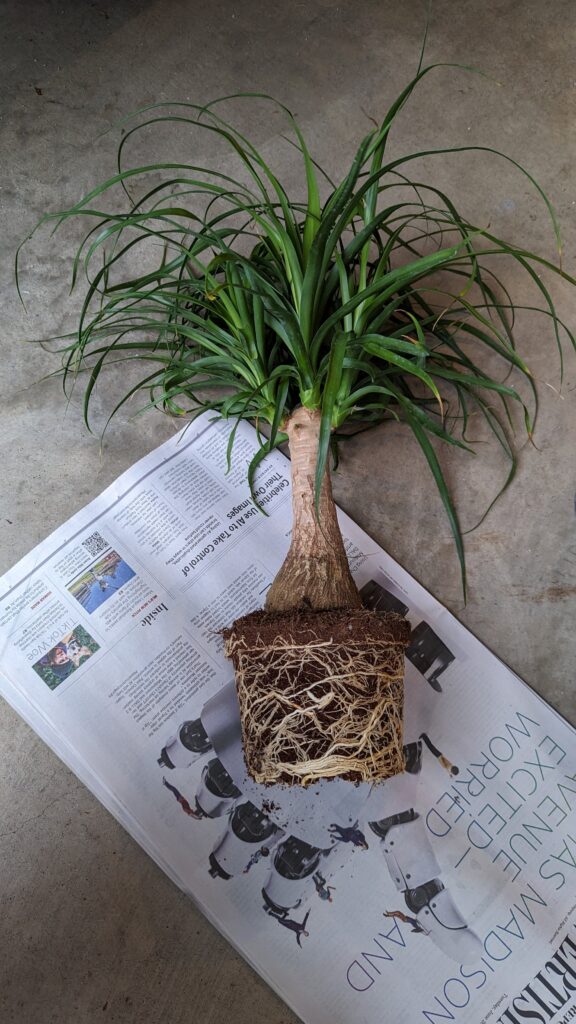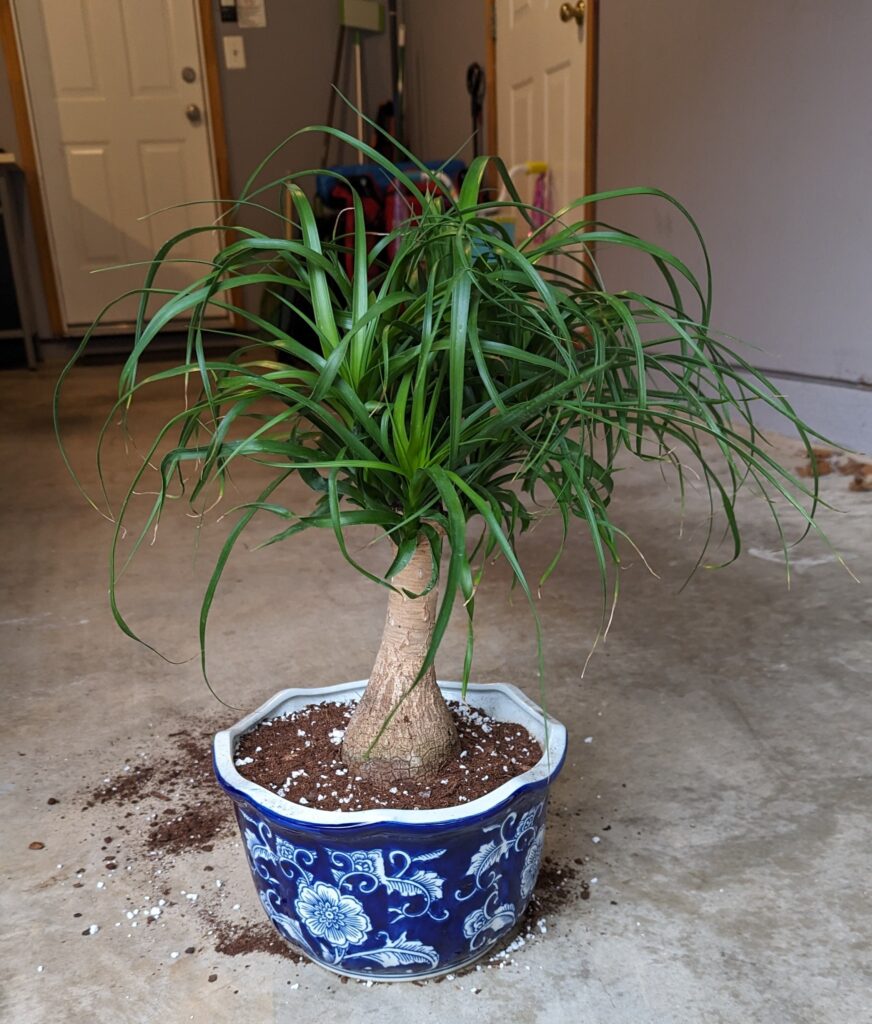Ponytail Palms are cute Dr. Suess-like plants. They can actually grow very tall, although it takes ages, and they look incredibly unique. This Ponytail Palm was definitely in need of some more room as you’ll see later in this post. Ponytail Palms are generally pretty easygoing plants so it can be hard to know when they need that extra care. Follow along in this post to learn about some signs that it’s time for Ponytail Palm repotting and how to do it step by step.
About Ponytail Palm
The Ponytail Palm is also known as a Pigtail Palm Elephant’s Foot plant. The trunk is bulbous towards the soil and holds water as its native habitat has long dry seasons. The top sprouts beautiful green leaves that are thin and swordlike although they can also be a bit curly. The Ponytail Palm is often listed as one of the easier houseplants because it has relatively low water and fertilization needs and can deal with not having the brightest light. I have kept mine near a south-facing window and it’s been pretty happy there.
| Light Needs | Watering Needs | Soil Needs | Fertilizing Needs |
| Bright to moderate direct light. | Let soil dry completely between waterings. | Well-draining potting soil. | A few times per growing season. |
The biggest thing you probably want to look out for is overwatering your Ponytail Palm. They don’t do well with moist soil. One great thing about Ponytails is that they are not toxic to dogs and cats. It’s still probably not advisable to let them chew on it though.
Signs That Your Ponytail Palm Needs Repotting
Roots are Bound or Showing
If your Ponytail Palm is showing roots either out of the bottom of the pot or out of the top of the soil, that’s a sign that you should repot it. If the roots are growing out of the pot that’s a sure sign that they need more room and more soil to grow into. More soil provides new nutrients and the ability to hold more moisture. There were roots growing out of the bottom of the pot of my Ponytail Palm pictured below. As you can also see the roots have pretty well filled out the old pot circling and crowding each other. Because of this, it was evident I needed to repot my Ponytail Palm.

Ponytail Palm Yellowing Leaves
If your Ponytail Palm has yellowing leaves that can be a sign of watering issues. Ponytail Palms often yellow from tip first. If the leaves are looking a bit droopy and limp then your plant needs a drink, that could be causing your yellowing leaves. It may also require a repot too if your plant is drying out too quickly between waterings. Yellowing leaves can also be due to overwatering. If you’re frequently overwatering your Ponytail Palm it could be a good idea to repot into a more well-draining soil and pot with plenty of drainage holes. A cheap and foolproof way to monitor soil moisture is a soil moisture meter.
Ponytail Palm Repotting Step-by-Step
You don’t need anything special to repot a Ponytail Palm. You’ll need the basics which are a new pot and some potting soil. What size pot do you need? The new pot should be about two inches in diameter larger than your old pot if you are up potting. If you are repotting for any other reason, aesthetic or moisture-related, then choose a pot that is two inches in diameter larger that the root ball. As I mentioned before, your new pot must also have drainage holes, Ponytail Palms like to dry out in between waterings. If you need to add drainage to your pot follow my tutorial on drilling ceramic and glass plant pots. Ponytail Palms don’t need a special soil mix they do well in regular potting soil. You may want to amend the potting soil with a little extra perlite to help further aid drainage.
Now for the repotting instructions. First, remove your Ponytail Palm from its old pot. Be careful, especially if it’s rootbound, as you don’t want to damage any roots. Once it is out of the pot, it’s always a good idea to inspect the roots. You don’t get to look at them often, so you might as well. Healthy roots are white and plump. Diseased roots are brown and mushy. If they are brown or mushy, follow up with my blog on overwatering for steps to address that.

After you have inspected the roots, you can try to loosen the root ball a bit which helps the roots grow in a better pattern rather than circling. Next, backfill your pot with soil to the height where you want the bottom of the root ball to sit. Then fill in the sides of the pot while you hold the Ponytail Palm in place. This is one of those plants that you want to make sure you have it planted vertically or else it will look weird, at least it does to me because it’s so top heavy. Repotting a Ponytail Palm is easy, you can see the final results above.
Post Repotting Care
Repotting your Ponytail Palm is a shocking event for a plant. You probably messed with the roots a bit and it’s in a totally new environment. Because of that, you want to eliminate further disruptions by taking it easy for a week or two to avoid Ponytail Palm shock. First, do not move it to a new spot if you can. It’s good to provide it with the same light, humidity, and other environmental factors immediately following a repot. In addition, wait a few days to water. Once you do start watering remember that you have a lot more soil now, which holds more moisture, so you may not be able to stick to your old watering schedule. Follow these tips and you Ponytail Palm should enjoy its new pot.
Ask your questions in the Comments section below.

I'm a long time plant lover on the quest to happily coexist with as many plants as I can. Let's grow!
